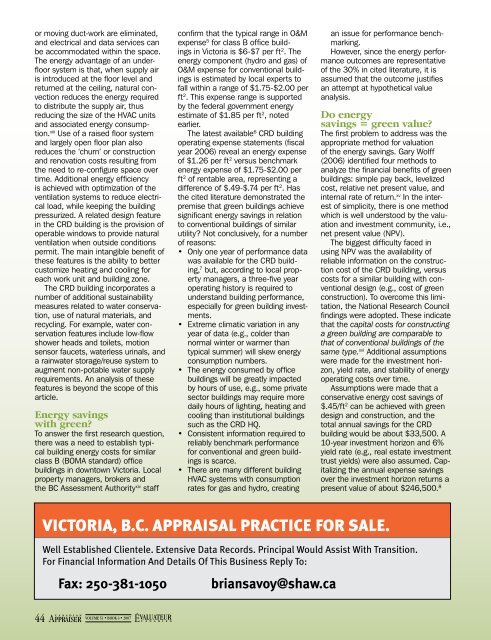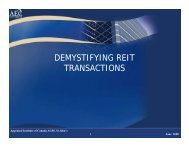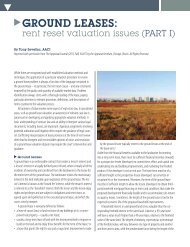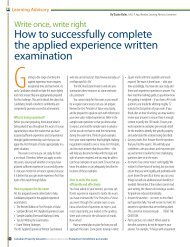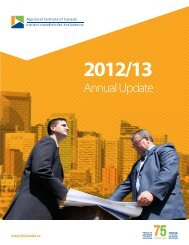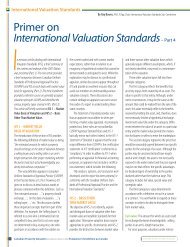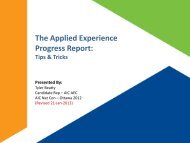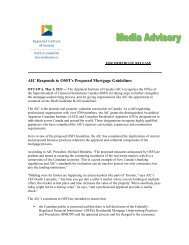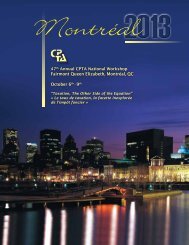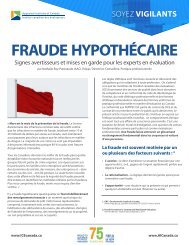or moving duct-work are eliminated,and electrical and data services canbe accommodated within the space.The energy advantage <strong>of</strong> an underfloorsystem is that, when supply airis introduced at the floor level andreturned at the ceiling, natural convectionreduces the energy requiredto distribute the supply air, thusreducing the size <strong>of</strong> the HVAC unitsand associated energy consumption.xiii Use <strong>of</strong> a raised floor systemand largely open floor plan alsoreduces the ‘churn’ or constructionand renovation costs resulting fromthe need to re-configure space overtime. Additional energy efficiencyis achieved with optimization <strong>of</strong> theventilation systems to reduce electricalload, while keeping the buildingpressurized. A related design featurein the CRD building is the provision <strong>of</strong>operable windows to provide naturalventilation when outside conditionspermit. The main intangible benefit <strong>of</strong>these features is the ability to bettercustomize heating and cooling foreach work unit and building zone.The CRD building incorporates anumber <strong>of</strong> additional sustainabilitymeasures related to water conservation,use <strong>of</strong> natural materials, andrecycling. For example, water conservationfeatures include low-flowshower heads and toilets, motionsensor faucets, waterless urinals, anda rainwater storage/reuse system toaugment non-potable water supplyrequirements. An analysis <strong>of</strong> thesefeatures is beyond the scope <strong>of</strong> thisarticle.Energy savingswith green?To answer the first research question,there was a need to establish typicalbuilding energy costs for similarclass B (BOMA standard) <strong>of</strong>ficebuildings in downtown Victoria. Localproperty managers, brokers andthe BC Assessment Authority xiv staffconfirm that the typical range in O&Mexpense 5 for class B <strong>of</strong>fice buildingsin Victoria is $6-$7 per ft 2 . Theenergy component (hydro and gas) <strong>of</strong>O&M expense for conventional buildingsis estimated by local experts t<strong>of</strong>all within a range <strong>of</strong> $1.75-$2.00 perft 2 . This expense range is supportedby the federal government energyestimate <strong>of</strong> $1.85 per ft 2 , notedearlier.The latest available 6 CRD buildingoperating expense statements (fiscalyear 2006) reveal an energy expense<strong>of</strong> $1.26 per ft 2 versus benchmarkenergy expense <strong>of</strong> $1.75-$2.00 perft 2 <strong>of</strong> rentable area, representing adifference <strong>of</strong> $.49-$.74 per ft 2 . Hasthe cited literature demonstrated thepremise that green buildings achievesignificant energy savings in relationto conventional buildings <strong>of</strong> similarutility? Not conclusively, for a number<strong>of</strong> reasons:• Only one year <strong>of</strong> performance datawas available for the CRD building,7 but, according to local propertymanagers, a three-five yearoperating history is required tounderstand building performance,especially for green building investments.• Extreme climatic variation in anyyear <strong>of</strong> data (e.g., colder thannormal winter or warmer thantypical summer) will skew energyconsumption numbers.• The energy consumed by <strong>of</strong>ficebuildings will be greatly impactedby hours <strong>of</strong> use, e.g., some privatesector buildings may require moredaily hours <strong>of</strong> lighting, heating andcooling than institutional buildingssuch as the CRD HQ.• Consistent information required toreliably benchmark performancefor conventional and green buildingsis scarce.• There are many different buildingHVAC systems with consumptionrates for gas and hydro, creatingan issue for performance benchmarking.However, since the energy performanceoutcomes are representative<strong>of</strong> the 30% in cited literature, it isassumed that the outcome justifiesan attempt at hypothetical valueanalysis.Do energysavings = green value?The first problem to address was theappropriate method for valuation<strong>of</strong> the energy savings. Gary Wolff(2006) identified four methods toanalyze the financial benefits <strong>of</strong> greenbuildings: simple pay back, levelizedcost, relative net present value, andinternal rate <strong>of</strong> return. xv In the interest<strong>of</strong> simplicity, there is one methodwhich is well understood by the valuationand investment community, i.e.,net present value (NPV).The biggest difficulty faced inusing NPV was the availability <strong>of</strong>reliable information on the constructioncost <strong>of</strong> the CRD building, versuscosts for a similar building with conventionaldesign (e.g., cost <strong>of</strong> greenconstruction). To overcome this limitation,the National Research Councilfindings were adopted. These indicatethat the capital costs for constructinga green building are comparable tothat <strong>of</strong> conventional buildings <strong>of</strong> thesame type. xvi Additional assumptionswere made for the investment horizon,yield rate, and stability <strong>of</strong> energyoperating costs over time.Assumptions were made that aconservative energy cost savings <strong>of</strong>$.45/ft 2 can be achieved with greendesign and construction, and thetotal annual savings for the CRDbuilding would be about $33,500. A10-year investment horizon and 6%yield rate (e.g., real estate investmenttrust yields) were also assumed. Capitalizingthe annual expense savingsover the investment horizon returns apresent value <strong>of</strong> about $246,500. 844C a n a d i a nAppraiserVolume 51 • book 4 • 2007EvaluateurC a n a d i e n
At this point, you may feel thecase study is more <strong>of</strong> an academicexercise, given the growing uncertaintyassociated with the assumptions.Can the findings be consideredconclusive? No - a single case studyis not sufficient to draw generalizedconclusions. Keep in mind that thatthe analysis <strong>of</strong> green value is a newarea <strong>of</strong> valuation practice and thegoal <strong>of</strong> this article is to illustrate howone might undertake a value analysis<strong>of</strong> the ‘green’ premium.SummaryThis article has provided anapproach for identifying green buildings,a simple method for quantifyingthe relationship between operatingexpenses and value, and some areasfor additional research. However,the main goal has been to awakenappraisers to green building trendsand the need to account for theimpact <strong>of</strong> ‘green’ on value. There aremany additional potential tangibleand intangible aspects to greenbuildings which can be investigated,such as reduced life-cycle cost,improved tenant relations and retention,reduced costs associated withchurn rate for interior space, etc.Are investors looking for this type<strong>of</strong> real estate intelligence? In GreenCan be Gold, author David Kozlowski,senior editor <strong>of</strong> Building OperatingManagement, cites an interview witha prominent Chicago developer stating,“There is not a lot <strong>of</strong> knowledgeor interest on the part <strong>of</strong> appraisersto go through all the bother <strong>of</strong> determiningNOI (net operating income)based on energy savings.” Kozlowskiunderscores the problem <strong>of</strong> appraisersfalling behind the industry withadditional examples <strong>of</strong> the importancebrokers, landlords and developersincreasingly place on NOI andenergy cost. The counterpoint is thatthe collective industry understanding<strong>of</strong> green building economics isso limited in <strong>Canada</strong> that the marketmay not be ready for ‘due diligence’in green building valuation, especiallysince much <strong>of</strong> the energy benefitsaccrue to tenants.This article has pointed out anumber <strong>of</strong> gaps in our knowledge <strong>of</strong>green building economics. Energizinggreen valuation research to the nextlevel will require partnerships andcollaboration between the appraisaland academic community, as well asreal estate organizations. Whetherinstitutional or fee, residential orcommercial, appraisers shouldrespond to the Vancouver ValuationAccord by:• learning about new building technologies;• staying connected with the evolution<strong>of</strong> green building trends andstandards;• monitoring market reactions tothe increasing number <strong>of</strong> newgreen buildings and buildingsrehabilitated to a green standard;and• increasing awareness <strong>of</strong> governmentpolicies to encourage andmandate green or sustainabledevelopment.As well, the <strong>Appraisal</strong> <strong>Institute</strong> <strong>of</strong><strong>Canada</strong> is encouraged to supportmore in-depth research on greenvaluation methodologies.End notes:1 Leadership in Energy and EnvironmentalDesign <strong>Canada</strong> New Construction,Green Building Council.2 Building Owners and Managers Association3 A 2004 BOMA BC study funded bythe Real Estate Foundation <strong>of</strong> BC,entitled Go Green Phase II Report,recommends that the initial focus forgreen building performance measurementshould be energy efficiencygains due to the complexity <strong>of</strong> analysisfor other factors such as waterand waste reduction4 The CRD provides a range <strong>of</strong> servicesfor unincorporated areas, and coordinatedregional and sub-regional inthe Greater Victoria area, such assolid waste disposal, water distribution,regional planning, affordablehousing, and health facility funding.5 Includes utilities (hydro, gas andwater), repairs and maintenance, andinsurance.6 The building is relatively new andbuilt in two phases. Hence, operatingexpenses for 2005 years were notrelevant.7 CRD property management staffnoted that the building systems willrequire further calibration to optimizeperformance.8 For simplicity, it is assumed thatenergy costs and yield rates will bestable over the investment period.References:i Federal Budget 2007. Preserving OurEnvironment and Modernizing HealthCare. http://www.budget.gc.ca/2007/themes/papemhe.htmlii Hume, Christopher (Feb.8, 2007).New Towers Paint the Town Green.Toronto Star. http://www.thestar.com/article/182962iii White, Anne (2007). What are theBarriers to Building Green Buildings?Real Estate News Exchange. http://www.renx.ca/Detailed/1243.htmliv BOMA BC (2005). Go Green PhaseII Report. http://www.greenbuildingsfoundation.org/research/data/BOMA.GGPII.Report.pdf.v Krisandra Guidry. How Green is YourBuilding? An Appraiser’s Guide toSustainable Design, <strong>Appraisal</strong> Journal,Winter 2004, p.58-61.vi World Commission on Environmentand Development, Our CommonFuture, New York, Oxford UniversityPress, 1987, p.4.vii Green Value: Green buildings, growingasset (2005). http://www.rics.org/NR/rdonlyres/93B20864-E89E-4641-AB11-028387737058/0/GreenValueReport.pdf.viii Kats, Gregory (2003). Green BuildingCosts and Financial Benefits. http://www.cap-e.com/ewebeditpro/items/O59F3481.pdf.ix EPA Energy Star Newsletter (2006Summer). http://www.energystar.gov/ia/business/guidelines/assess _ value/<strong>of</strong>f _ the _ charts _ summer _ 2006.pdf.x Energy Efficiency for the CommercialConstruction and ManagementIndustries (2007).http://www.em.gov.bc.ca/AlternativeEnergy/EnergyEfficiency/energyefficiencypdfs/information_ for/Energy _ Commercial _07.pdf.xii An Architect’s Guide to SustainableDesign <strong>of</strong> Office Buildings (2005).http://www.pwgsc.gc.ca/realproperty/text/pubs _ archguide/pubs _ archguide_ 4-e.html.xiii Spinazzola, S. (2005). Air DistributionTurned Upside Down. BuildingOperating Management. http://www.facilitiesnet.com/bomarticleemail/BOMarticle111805.html.xiv Personal interviews conducted March1 to March 31, 2007.xv Wolff, G. Beyond Payback: A Comparison<strong>of</strong> Financial Methods for Investmentsin Green Buildings, Journal<strong>of</strong> Green Building. Vol 1(1).(2006).p.82.xvi National Research Council (2005).Green Buildings: Capital and Life-Cycle Costs. http://irc.nrc-cnrc.gc.ca/sbe/greencapital _ e.htmlJohn Peebles, AACI, P. App is aValuation Consultant with D.R.Coell & Associates in Victoria, BC.C a n a d i a nAppraiserE CVolume 51 • book 4 • 2007 valuateura n a d i e n 45


